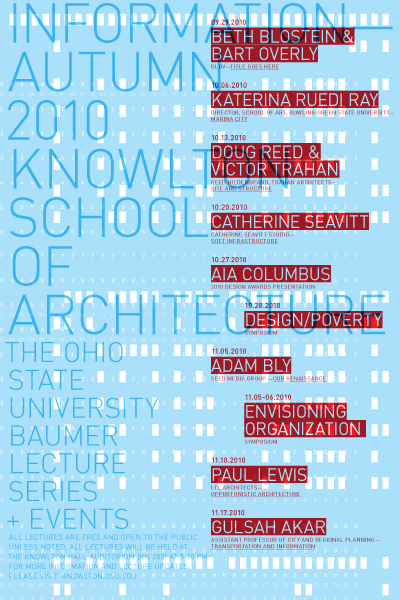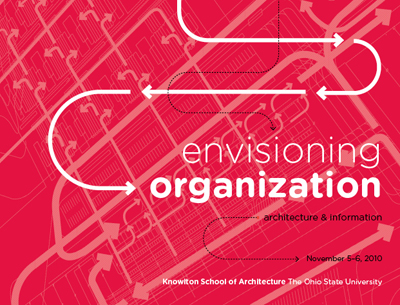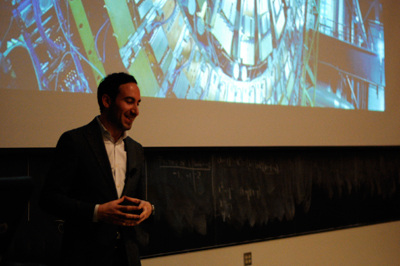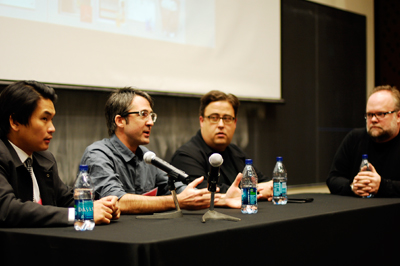
Sep '09 - Oct '11
It has certainly been quite a while since I last updated this page. I apologize to anyone who's following it. My goal is to get something brief up here every week or two from now on - because there is certainly a lot going on/that has gone on. It's just difficult to not make a blog posting a full-blown event. I always feel like I have to prepare some extraordinary presentation of images and text, which is not the case.
This quarter has brought on a lot of interesting work, lectures, conferences, and now a new student publication called One:Twelve.
Let's start with the lectures:
Thus far, we've had a stimulating set of lectures from a prominent group of practitioners and theorists. As with every lecture series here at the KSA, the series has been complemented by gallery openings and symposiums.
This past Friday we were given a keynote lecture by Seed Magazine editor, Adam Bly as part of the Envisioning Organization conference - organized by KSA Assistant Professor Karen Lewis.
Through an interesting presentation of data visualizations, scientific thoughts, and theories on the role of designers as related to scientists, Adam demonstrated his knowledge as a scientist, offering little on the role of a designer. An immediate response to his lecture may conclude that his position towards designers is that designers act simply as illustrators in order to make data look pretty. Although I would agree that this was the case, I would also say that he took a particularly strong stand to the thought that design needed to become a recognizable face that is as prevalent and important as science. The issue with taking that position is the questioning that follows. How do designers come to the forefront? How do you value design beyond its pretty pictures?
Adam at one point declared that science will always be on the front page in the media and that design, at this point, typically hides away in the jumble of secondary pages. He said designers and scientists must work in the same building and with each other in order for design to make a strong presence like that of science - at least for now. I would argue that design and science are not so separate. In fact, Adam spoke of the idea that science and design were at a turning point where both depended upon one another for continued evolution. It seems to me that design and science have always worked together - actually, I would say that design is in its own way a science. Most design incorporates very specific scientific information in order to realize the design. Look at the work of any automobile designer, Apple or Microsoft, or any architect. Does this make scientists designers, too? Maybe. But are all designers scientists, and all scientists designers? Absolutely not.
I think what Adam was trying to get through to the audience was this idea that designers and scientists work back and forth between disciplines all the time, and rely on one another for success. However, I believe he poorly portrayed the designer as an illustrator, and the scientist as the author. And quite often, this is how the public views this problem - that scientists are practical and precise, and that designers only care about their whimsical fantasies through pretty form and aesthetic. Both Adam and Seed Magazine are in a place to debunk this misconception, and it is unfortunate that it didn't come through that way Friday evening.
------------
The Envisioning Organization conference was kicked off by Adam's lecture, but really showed it's color (everything was bright pink) for an all-day Saturday event. A true designer conference, Envisioning Organization brought architects, graphic designers, mapping experts, critics, scientists, and academics into the same room to discuss the multi-faceted topics of architecture and information.
Broken into four parts, augmentation; clarification; simulation; and revelation, the conference attempted to contain similar practices and interests into easy to manage bites. In retrospect, I feel those section titles were a little blurry, as it seemed most of the presentations were stock lecture powerpoints - no person truly addressed the title they were under. However, after three presentations each, I felt the individual moderators did a great job bring the work together into a discussion topic.
Being very interested in the intersections of architecture and graphic design, I was especially interested in the "simulation" section, moderated by John McMorrough. The first presentation was by Scott Stowell of Open. He discussed a number of graphic projects - identities and way-finding systems - with a witty sense of humor. During the discussion, Scott made the comment that they try to "stupify" their projects and state the obvious. He was quick to clarify that the stupification of their work does not undermine its sophistication. Rather, it's much harder to go through a complex process of design and tell the whole story in a single sentence.
Christian Unverzagt of M1/DTW followed Scott, whm I saw lecture my sophomore year at Kent State. Their work has always interested me because of its multi-disciplinary sense.
The last presentation was given by former KSA LeFevre Fellow Jimenez Lai of Bureau Spectacular. Of the three presentations, this one floored me. I remember seeing his comic work on Archinect sometime in undergrad, but never knew who had done it. Jimenez has clearly been influenced by Jeff Kipnis in the way that narrative informs all of his work. In fact, his work is an architectural narrative. Jimenez is making architecture fun again through his descriptive stories and drawings, while giving the discipline a new vernacular of expression.
Overall, I thought the conference was an interesting success, full of great work and ideas. However, I do wish the presentations would have more directly addressed the section under which they were listed. I became more fascinated by the discussions after the presentations, and continually wished that the individual presentations would have been shorter in order to allow for more discussion of topics within the panel. With a shorter, concise presentation addressing the overall issue of the conference, while looking closely at the section they were assigned, I feel there would have been more intense discussion. However, it's hard to have dynamic discussion if nobody knows where you come from. I guess I felt like the moderators had to labor in order to find common ground between some of the presentations, which had to allow time for it to be found in the discussion rather than having the conversation take off with ease.
------------
Finally, a big step forward after our beginning of the year Production gallery that focused on the question, "Why doesn't the KSA have any publications?" Aside from the Sourcebook series and Praxis being housed at the KSA, there is no formal student work journal, nor was there a cohesive cross-discipline student voice within the school. Until now.
This quarter, myself and third year undergrad Josh Kuhr took it upon ourselves to start a student publication.
From the Introduction to Issue 001:
One:Twelve began as a question that became an idea, and is now ready to leap forward and ask questions and generate ideas. One:Twelve becomes what the KSA student body wants it to be, and offers a progressive medium for the always-changing worlds of design and student culture.
As a student collaborative searching for the voice of the Knowlton School of Architecture, One:Twelve is aimed at collecting the provocative ideas and intensities of the School’s environment into a raw, dynamic platform of expression and analysis. Through the sharing of theories, experiences, and culture, One:Twelve becomes the voice of the students across physical and disciplinary boundaries, offering an intimate dialogue between local and even global communities.
Much like the built environment of the KSA, One:Twelve is a permanent catalyst for student and faculty interaction. It offers a common platform that weaves between classroom and culture, always looking for new relationships between those that are seemingly separate. The ramps of Knowlton Hall create a multi-level system of balconies, terraces, and platforms that stitch together these varied environments of the School, and give way to the Title of our new student journal.
Although not looking for answers, One:Twelve is constantly asking questions of the environment it directly represents. Through stories, research, investigations, and conversation, One:Twelve shares the dynamics of a constantly evolving culture, creating multiple transparencies in the hopes of facilitating a self-examination of the school, the city, and the profession through creative discourse.
Simply stated, the goal of One:Twelve is one that acts as an ever-changing link between the disciplines of Architecture, Landscape Architecture, and City and Regional Planning here at the Knowlton School of Architecture.
Our goal with One:Twelve is to produce two issues a quarter. We're super excited about this and the ways it can evolve with more participation. We're working hard to get a Tumblr up and running, as well as some sort of website on Knowlton's page. But all of this will come in time. However, soon, I hope to get the digital copy of Issue 001 up on the KSA web page so anybody can download it. I'll keep you all posted...
If for any reason you should need to contact the staff of One:Twelve, feel free to email us at onetwelveksa@gmail.com. And if you're in the KSA, please let us know if you'd like to contribute to the next issue...in fact, maybe we'll have an alumni section sometime too...anyone interested? Let us know!
------------
This week's lecture:
Paul Lewis, LTL Architects
Wednesday, November 10
5:30 pm / KSA Auditorium
FREE & OPEN TO THE PUBLIC
See you soon.



No Comments
Block this user
Are you sure you want to block this user and hide all related comments throughout the site?
Archinect
This is your first comment on Archinect. Your comment will be visible once approved.